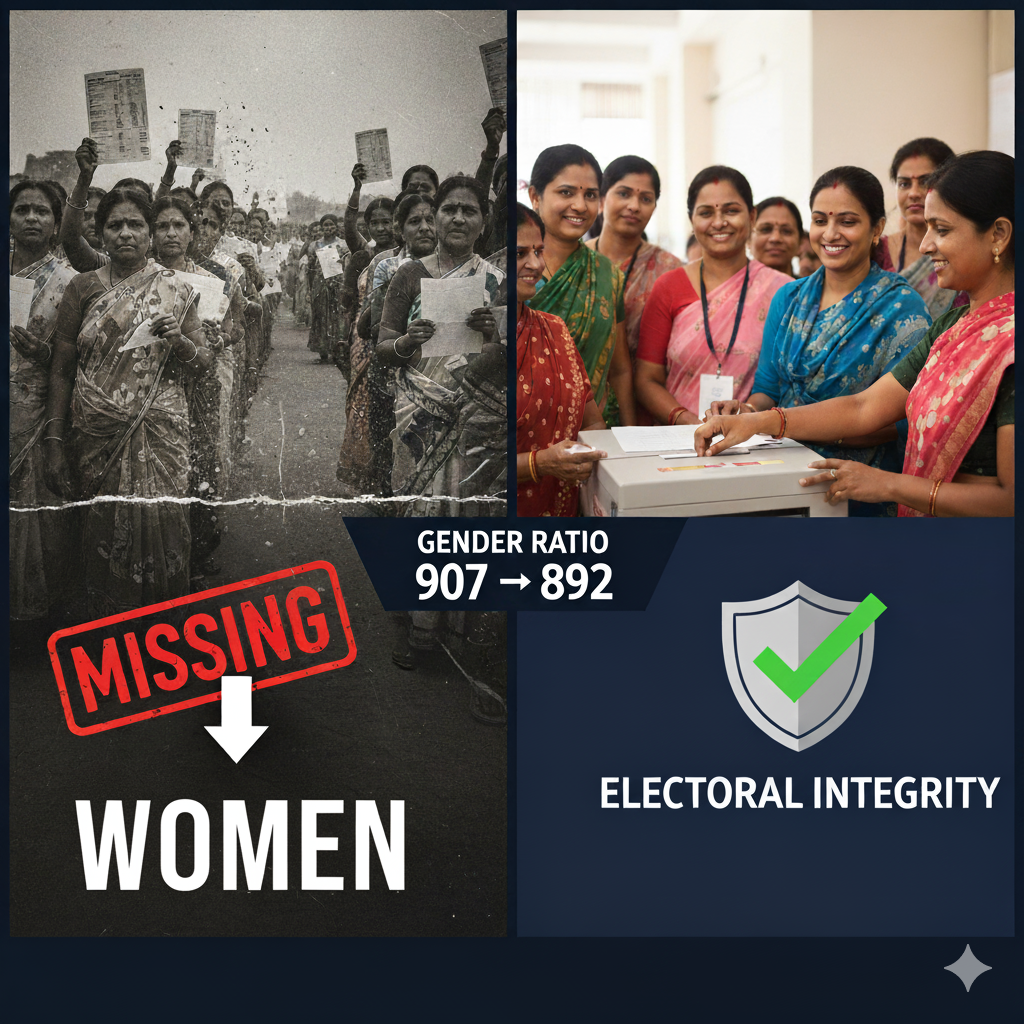Key Highlights
- Massive Disenfranchisement: Bihar’s SIR deleted 38 lakh voters between January-September 2025, with nearly 60% (22.75 lakh) being women despite men forming the majority of migrants
- Gender Ratio Regression: Gender ratio plummeted from 907 women per 1,000 men (January) to 892 (September), erasing a decade’s progress in women’s electoral participation
- Disproportionate Impact: Women faced 6.1% deletion rate compared to 3.8% for men, with 37 out of 38 districts showing higher women deletions
- Systemic Bias Evidence: Official explanations fail to account for the 7 lakh additional women deletions, pointing to literacy gaps and household prioritization biases
- Supreme Court Intervention: Court directing para-legal support for affected voters while questioning ECI’s methodology and demanding transparency in deletion processes
The Scale of Bihar’s Electoral Crisis
Bihar has witnessed the largest electoral roll shrinkage in Indian history through its Special Intensive Revision (SIR) exercise, conducted between June-August 2025. The numbers are staggering: from 7.80 crore registered voters in January 2025, the state now has just 7.41 crore voters – a reduction of nearly 38 lakh people. barandbench
This isn’t merely an administrative adjustment. The 80 lakh gap between Bihar’s estimated adult population (8.22 crore) and registered voters (7.42 crore) represents 10% of the state’s entire adult population potentially disenfranchised. To put this in perspective, this single revision exercise has created more “missing voters” than some entire Indian states have total population.
The demographic composition of these deletions reveals a troubling pattern that challenges the very foundations of inclusive democracy. Women, who should constitute roughly half the electorate, bore the disproportionate burden of exclusion, raising fundamental questions about the fairness and neutrality of India’s electoral processes.
Decoding the Gender Disparity
The gender breakdown of deletions exposes a systematic bias that cannot be explained by natural demographic patterns. Male voters decreased by 1.55 lakh (3.8%), while female voters dropped by 2.27 lakh (6.1%) – creating an additional burden of approximately 7 lakh women who were deleted beyond what demographic parity would suggest. youtube
This disparity manifests across Bihar’s geography with remarkable consistency. In 37 out of 38 districts, women faced higher deletion rates than men, indicating a state-wide pattern rather than isolated regional anomalies.
Gopalganj presents the most extreme case: women’s numbers fell by 14.9% while men declined by only 7.8%. The district lost 1.5 lakh women voters – from 10.3 lakh in January to 8.3 lakh in September. Similarly, Kishanganj saw women deletions at 11.9% compared to 5.5% for men.
Even in districts with moderate overall deletions, the gender gap persists. Patna, Bihar’s largest district by electorate, recorded 4.1% women deletions versus 3.5% for men. Muzaffarpur and Samastipur show similar patterns, suggesting the bias transcends urban-rural and demographic boundaries.
Testing Official Explanations Against Evidence
The Election Commission of India attributes deletions to four primary categories: deaths, duplicate registrations, permanent migration, and untraceable/shifted addresses. However, systematic analysis reveals these explanations cannot account for the observed gender disparity. ijfmr
The Death Rate Paradox
Bihar’s official mortality records contradict ECI’s deletion patterns. State data from 2018-2022 shows men account for nearly 60% of deaths annually, yet women comprised 53% of deletions attributed to deaths during SIR. This inversion of expected mortality patterns suggests classification errors or systemic bias in verification processes.
The Migration Myth
Perhaps the most significant contradiction emerges in migration patterns. Census data reveals that for every 100 female migrants in India, only 7.2 move inter-state while 92.6 migrate within state boundaries. Conversely, men show 31.4 inter-state and 65.6 intra-state migration per 100 migrants.
Bihar-specific research confirms this pattern. Men dominate long-distance migration for employment, while women primarily migrate for marriage within Bihar. Yet SIR data shows 61% of “permanently shifted” deletions were women, with only 39% men – directly contradicting established migration patterns.
The age-wise breakdown further exposes this contradiction. Among 18-29 year-olds deleted as “permanently shifted,” 73% were women compared to just 27% men. This demographic experiences the highest male out-migration for employment, making the female-skewed deletions even more inexplicable.
Border Factor Limitations
ECI officials attribute some disparity to “cross-border factors,” particularly women from Nepal marrying into Bihar without surrendering Nepali citizenship. While this may explain deletions in specific northern border districts like Kishanganj, the pattern appears across all 37 districts showing female deletion bias, including areas with no international borders.
The Age Dimension: Young Women Bear the Brunt
Age-wise analysis reveals the most troubling aspect of SIR’s impact. Deletions concentrate among women under 40 years, with the 18-29 category showing the highest exclusions. This demographic represents prime reproductive and economic years, when women’s political participation becomes crucial for household and community representation.
The ECI explanation of “marriage migration” fails scrutiny when examined against marriage patterns in Bihar. Census data indicates that 92.6% of female migration occurs within state boundaries, typically involving movement between villages or districts rather than interstate relocation that would justify electoral roll deletion. ies.gov
This age-specific targeting of young women deletions raises concerns about systematic exclusion of women in their most politically active years, potentially affecting electoral outcomes and representation patterns for decades.
The Literacy-Procedure Nexus: Understanding Systemic Bias
The most plausible explanation for disproportionate women deletions lies in the intersection of low literacy rates and procedural complexities. Bihar has India’s lowest female literacy rate at approximately 53.7% compared to 76% for males – a gap that translates directly into electoral vulnerability.
SIR’s self-enumeration process required households to independently fill and submit complex forms within a compressed 40-day timeline. This procedure creates multiple barriers for women:
Documentation Challenges: Women, particularly married women, often lack individual documentation linking them to current addresses, especially when surnames change post-marriage. The requirement to trace lineage to 2003 electoral rolls creates additional hurdles for women who may not have been registered two decades ago.
Household Prioritization: Cultural norms often result in male family members completing forms, potentially neglecting women’s entries or providing incomplete information. The pattern suggests families prioritize male registration while treating women’s electoral participation as secondary.
Procedural Complexity: Low literacy rates make form completion challenging, with verification processes potentially biased against women’s entries due to incomplete or incorrect submissions.
Political and Electoral Implications

The electoral consequences of SIR extend far beyond mere numbers. Women voters have historically shown higher turnout rates than men in recent Bihar elections – from 42.5% in 2005 to 59.7% in 2020, while male turnout rose from 49.9% to 54.4%. This higher engagement makes women’s exclusion particularly impactful for electoral outcomes.
The gender ratio regression from 907 to 892 women per 1,000 men erases gains accumulated over a decade. The gap between male and female voters, which had narrowed to 7 lakh in January 2025, has now expanded to 16 lakh – returning to levels last seen in 2012. thewire
This demographic shift could significantly alter constituency-level outcomes, particularly in areas where women’s preferences diverge from men’s voting patterns. Political parties that relied on women’s support may face unexpected challenges, while the exclusion patterns could systematically benefit certain political formations over others.
Supreme Court Scrutiny and Legal Challenges
The magnitude of Bihar’s SIR has prompted unprecedented judicial intervention. The Supreme Court is hearing multiple petitions challenging the revision methodology and outcomes, with the bench of Justices Surya Kant and Joymalya Bagchi expressing concern over potential mass disenfranchisement.
Yogendra Yadav, appearing as petitioner, presented damning evidence to the court. His analysis revealed that SIR created three forms of exclusion: systemic, structural, and potentially targeted. The court data showed alarming procedural irregularities, including 45,000 “gibberish” names, over 4 lakh entries with house number “0,” and data in Tamil and Kannada in Bihar’s rolls.
The Court has directed deployment of para-legal volunteers and government lawyers to assist affected voters in filing appeals, recognizing that the absence of individual notifications prevented people from challenging wrongful deletions. This intervention acknowledges the procedural flaws that contributed to mass exclusion.
The ECI’s defense that “no one has challenged exclusions” has been effectively countered by evidence of systematic barriers to appeals, including lack of notifications, compressed timelines, and complex procedures that disadvantage low-literacy populations.
District-Level Variations: Border Effects and Administrative Capacity
The geographic distribution of deletions reveals interesting patterns that provide insights into underlying causes. Border districts show mixed results – while Kishanganj (Nepal border) has high women deletions, other border districts like Araria and Supaul show varied patterns, suggesting border proximity alone doesn’t explain the disparity.
Administrative capacity appears to correlate with deletion patterns. Districts with stronger administrative systems show more balanced deletion rates, while those with weaker infrastructure demonstrate greater gender disparities. This suggests that procedural support and verification quality significantly influence outcomes.
The rural-urban divide also emerges as a factor. Urban areas with higher literacy rates and better administrative reach show smaller gender gaps in deletions, while rural areas – where women face greater documentation and procedural barriers – experience more severe disparities.
Comparative Analysis: Historical Context and National Implications
Bihar’s SIR represents an unprecedented scale of electoral roll revision in independent India. Previous revisions, even intensive ones, have not approached this magnitude of exclusion. The exercise’s compressed timeline and self-enumeration methodology created a perfect storm for systematic exclusion of vulnerable populations.
The pattern raises concerns about potential replication in other states. As Yogendra Yadav warned the Supreme Court: “I hope this does not happen across the country”. The Bihar experience could serve as either a cautionary tale or, worryingly, a template for similar exercises elsewhere.
The demographic impact extends beyond immediate electoral considerations. Systematic exclusion of women from political participation undermines democratic representation and could discourage future political engagement among affected populations.
Institutional Responses and Reform Imperatives
The Bihar SIR crisis exposes fundamental weaknesses in India’s electoral administration that require immediate attention. The Election Commission’s initial resistance to transparency and accountability has been overcome only through judicial intervention, raising questions about institutional commitment to inclusive democracy.
Key reforms must address:
Procedural Safeguards: Mandatory assisted enumeration for low-literacy populations, extended timelines for verification and appeals, and individual notifications for all deletions.
Gender Sensitivity: Specific protocols for verifying women’s entries, recognition of marriage-related documentation challenges, and training for electoral officials on gender-sensitive administration.
Transparency Mechanisms: Regular publication of demographic-disaggregated data, independent audits of revision methodologies, and public disclosure of deletion reasons with statistical analysis.
Appeal Infrastructure: Simplified appeal processes accessible to marginalized populations, free legal aid for challenging wrongful deletions, and community-level assistance centers.
Perspective: Governance and Democratic Theory
Bihar’s SIR offers critical insights into the complexities of democratic administration. The case illustrates how procedurally neutral policies can produce systematically biased outcomes, requiring explicit corrective mechanisms to ensure equitable results.
The federalism dimensions are particularly significant. While electoral administration involves central guidelines, state-level implementation reveals the importance of local administrative capacity and political commitment in protecting democratic rights.
The crisis also highlights intersectionality in governance – how gender, literacy, rural residence, and economic status compound to create multiple disadvantages that neutral procedures can exacerbate rather than ameliorate.
Democratic legitimacy concerns emerge when electoral processes systematically exclude specific demographic groups. The balance between electoral roll accuracy and inclusive participation represents a fundamental challenge for election management bodies globally.
Forward: Protecting Democratic Participation
Bihar’s SIR experience must catalyze comprehensive reform of electoral administration to prevent similar crises. The immediate focus should be on restoring wrongfully deleted voters through the Supreme Court-mandated appeal process, with adequate support for affected populations.
Long-term reforms require:
Legislative Intervention: Statutory safeguards against mass disenfranchisement, mandatory gender impact assessments for electoral processes, and enhanced legal aid provisions for voters challenging deletions.
Institutional Strengthening: Capacity building for electoral officials on gender-sensitive administration, development of technological tools that assist verification while preventing exclusion, and strengthened state election machinery.
Civil Society Engagement: Partnership between ECI and civil society organizations for outreach, community-level assistance during revision processes, and independent monitoring of electoral administration.
Research and Monitoring: Regular demographic analysis of electoral rolls, systematic study of revision methodologies’ impact on different populations, and evidence-based policy recommendations for inclusive electoral administration.
The Democratic Stakes
The Bihar SIR crisis transcends immediate electoral considerations to touch the fundamental principles of Indian democracy. When 10% of a state’s adult population can be excluded from electoral participation through a single administrative exercise, the very foundations of representative government face serious challenges.
The gender dimension adds particular urgency to these concerns. Women’s political participation has been gradually increasing across India, representing hard-won progress toward inclusive democracy. Systematic reversal of this progress through administrative procedures threatens not just individual rights but the broader democratic project.
The Supreme Court’s intervention provides hope for immediate redress, but lasting solutions require sustained commitment to reform electoral administration with explicit attention to protecting vulnerable populations. Bihar’s experience must serve as a catalyst for creating more inclusive, equitable, and transparent electoral processes.









+ There are no comments
Add yours